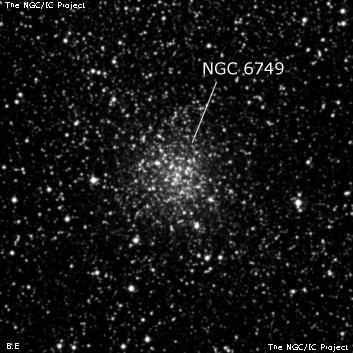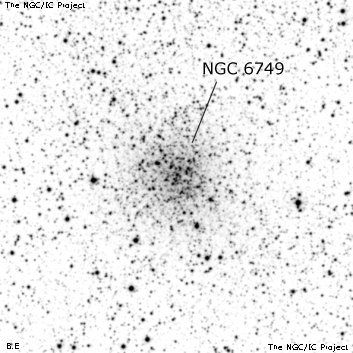NGC/IC Project Restoration Effort
(This is a very very beta version)
NGC6749


Basic Information
Location and Magnitude
Right Ascension: 19:5:15.3
Declination: +1:54:5
Constellation: AQL
Visual Magnitude: 12.4
Historic Information
Discoverer: Herschel J.
Year of discovery: 1827
Discovery aperture: 18.3
Observational
Summary description: Cl, L, lC, st L ___DREYER___ S
Sub-type: GCL
Corwin's Notes
=====
NGC 6749. Steve Gottlieb pointed out to me in an email in August 2016 that
the globular cluster usually associated with this NGC number does not match
JH's position or description. His position is roughly eight arcminutes off,
not terribly far from the globular, but his description "A cluster of loose
small stars of various magnitudes; fills the field" is not at all concordant
with the appearance of the cluster. Steve's several observations of the
globular with telescopes ranging in size from 13 inches to 24 inches are also
at odds with JH's description.
I've left the globular in the position table with the appropriate name "N6749
nearby GC" as a precaution against identifying it with JH's NGC 6749. I also
recognize that this will be a difficult change to "enforce", given that the
globular has carried this NGC number for many years.
A more appropriate scattering of stars actually overlaps the globular but
extends well to the southwest. Bigourdan examined the area on 24 August 1891
and wrote (my translation), "Extended region, slightly rich in stars, but
which offers nothing remarkable." This is exactly my own assessment of the
area. So, even if this is JH's intended object, I think that it is no more
than a random clumping of Milky Way stars.
Steve's Notes
=====
NGC 6749
24" (7/20/12): NGC 6749 was surprisingly easy to sweep up at 200x and it was immediately noticed in the field as a fairly faint, fairly large, irregular glow, ~2.5' diameter.Ê Still, the surface brightness is low for a globular, there was no noticeable concentration, and it somewhat blends into a rich Milky Way star field.Ê At 325x several very faint stars were resolved, mostly around the edges.Ê The easiest group to resolve are four or so along the north and northeast side.Ê Another couple of stars are at the south and southeast edges.Ê Brighter (field?) stars are off the southwest and east edges.
18" (8/2/11): this challenging NGC globular is highly obscured and just stands out clearly from the rich Milky Way background glow. At 225x it appears as a very faint diffuse glow, roughly 2' diameter, with a low surface brightness and a small brighter core. A 12th magnitude star is superimposed and the slightly brighter core of the globular is located about 45" SW of this star. The edge of the globular is not well defined but appears to just reach a mag 12.5 on the south end. Additional mag 11-13 stars are clearly off the east, west and south side of the halo. Four mag 12-13 stars just off the south side form a small trapezoid that helps to pinpoint the location of the globular. Located 26' ENE of mag 5.8 HD 177178.
17.5" (7/1/00): very faint, very low surface brightness globular in a dusty portion of the Aquila Milky Way (dimmed by at least 4.5 magnitudes of extinction). The core is 15"-20" slightly brighter spot less than 1' SW of a mag 12 star. The surrounding halo is just a weak glow with averted vision, 2'-2.5' in diameter with an ill-defined edge, and just brighter than the Milky Way background. The glow encompasses the mag 12 star on its northeast side but does not reach two mag 13.5 stars off the south side. This cluster would most likely be overlooked if just quickly scanning the field and along with NGC 6380 it is one of the two most difficult NGC globulars!
17.5" (7/24/95): very faint, ~3' diameter, unusually low surface brightness for a globular cluster with only a very weak central brightening. A mag 12 star is superimposed on the north side and two mag 13.5 stars are at the south end (not members). The core appears to be located ~1' SW of the mag 12 star. Does not appear like a globular but rather a diffuse nebula in a rich Milky Way field. Difficult to determine exact outer extent.
13" (8/11/85): extremely faint, moderately large, very low surface brightness and fades at high power. Near the visual threshold this is one of the two faintest NGC globulars along with NGC 6380. Estimate V = 14. Located at the NW edge of an elongated group of six mag 12/13 stars and 25' ESE of mag 5.8 SAO 124203. The position listed in the NGC, SC2000, NGC 2000, U2000, and DSFG are all about 7' too far south.



